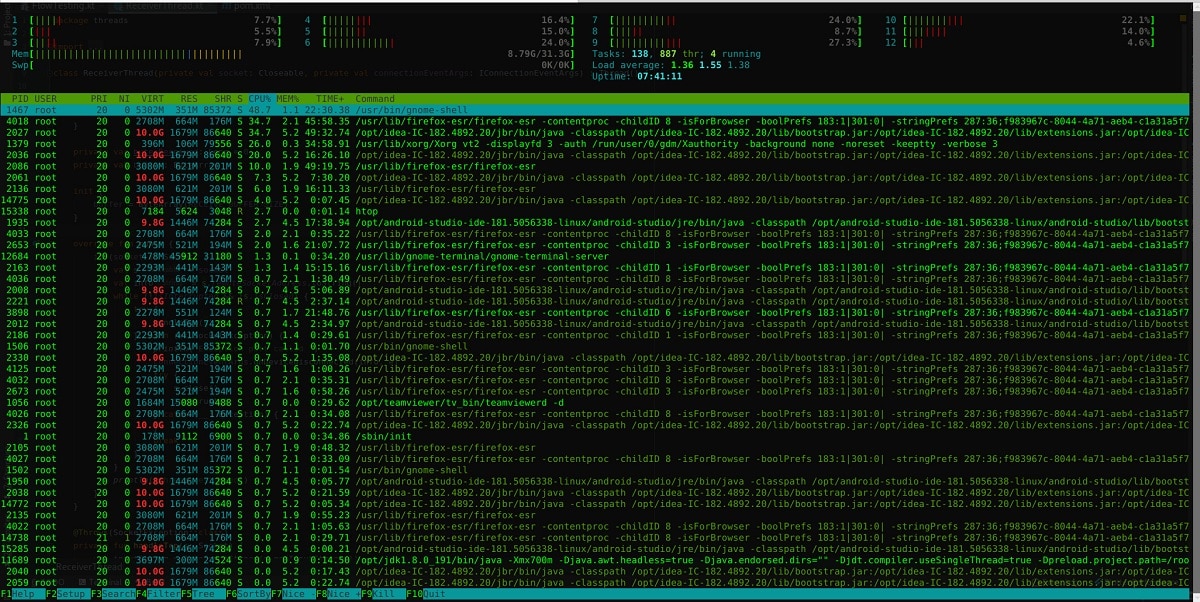
Launch of the new version of the diagnostic utility htop 3.0 which was developed by a new work team I decided to take the project due to its inactivity and the need to solve several errors detected.
For those who are unfamiliar with htop, they should know that this is an interactive system monitor, Process viewer and process manager designed for Unix systems.
Originally designed as an alternative to the top Unix program, provides much of the same functionality as top, but offers much greater flexibility in how system processes can be viewed.
Unlike top, htop provides the complete list of running processes instead of those that consume more resources. Htop can display processes as a tree and uses colors to provide resource usage statistics.
Utility stands out for features such as vertical and horizontal scrolling in the process list, tools to evaluate the efficiency of SMP and the use of each processor core, the presence of a tree view mode, flexible interface configuration, support for filtering processes and managing them (shutdown, priority setting) .
Main new features of htop 3.0
This new version, is a release that was prepared by a new team of maintainers which took over development after the original author's long inactivity of the project (little more than two years) and in addition to that there were already several errors detected.
The new maintainers forked the project without a name change, they moved development to the new htop-dev repository and registered a separate htop.dev domain for the project.
And of the changes that were implemented in this first version launched by the new team support for new parameters with information about accumulators in sysfs is highlighted.
As well as an added option to disable the mouse.
Another of the changes that is integrated is that ZFS statistics are now supported ARC (Adaptive Replace Cache), plus displaying more than two compact columns is supported with CPU status indicators.
Of the other changes that occur in this new version:
- Support for metrics provided by the PSI (Pressure Stall Information) kernel subsystem.
- Ability to display CPU frequency on CPU status indicators.
- Added simple alternate mode with keyboard shortcuts like in vim.
- Compatible with Solaris 11.
- Supports Linux proportional set size metrics
- Supports Linux pressure lock information metrics
- Linux sysfs battery discovery update for latest kernels
- Add hardware topology information in the affinity panel
- Add timestamp reports to the home screen
- Supports fewer (1) search navigation shortcuts
- Update the FreeBSD maximum PID to match the FreeBSD change
- Report values greater than 100 terabytes
- BUGFIX: fix makefiles to build with clang
- BUGFIX: fix primary use ()
- BUGFIX: fix STARTTIME column in FreeBSD
- BUGFIX: truncate general jail names on FreeBSD
- Fixed memory values reported in FreeBSD
- Fixed CPU meter reported values in OpenBSD
- Fixed correct identification of other types of zombie processes
- Improvements were made to handling the follow-up process in some situations
- Correction made on custom meters reverting to unexpected settings
How to install htop 3.0 on Linux?
For those who are interested in being able to install this new version of the tool, they must obtain the .tar package from the official website of the application. And even though htop is a fairly popular application due to the bifurcation by the new team, it may take a long time for this new version to be included in the repositories of Linux distributions.
That is why we can download the package for compilation from the terminal with:
wget https://github.com/htop-dev/htop/archive/3.0.0.tar.gz ./configure && make ./autogen.sh && ./configure && make